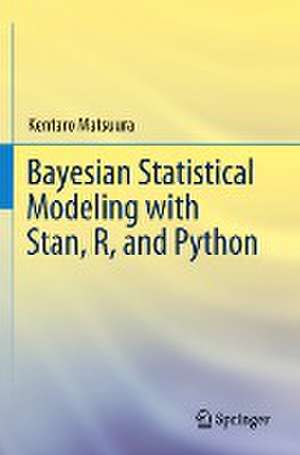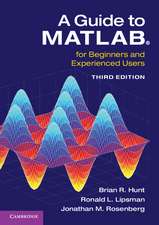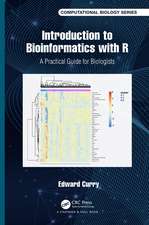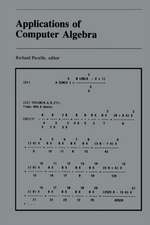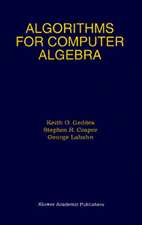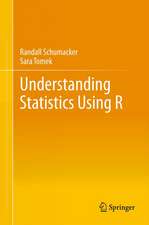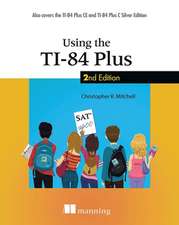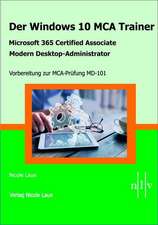Bayesian Statistical Modeling with Stan, R, and Python
Autor Kentaro Matsuuraen Limba Engleză Paperback – 25 ian 2024
The book is divided into four parts. The first part reviews the theoretical background of modeling and Bayesian inference and presents a modeling workflow that makes modeling more engineering than art. The second part discusses the use of Stan, CmdStanR, and CmdStanPy from the very beginning to basic regression analyses. The third part then introduces a number of probability distributions, nonlinear models, and hierarchical (multilevel) models, which are essential to mastering statistical modeling. It also describes a wide range of frequently used modeling techniques, such as censoring, outliers, missing data, speed-up, and parameter constraints, and discusses how to lead convergence of MCMC. Lastly, the fourth part examines advanced topics for real-world data: longitudinal data analysis, state space models, spatial data analysis, Gaussian processes, Bayesian optimization, dimensionality reduction, model selection, and information criteria, demonstrating that Stan can solve any one of these problems in as little as 30 lines.
Using numerous easy-to-understand examples, the book explains key concepts, which continue to be useful when using future versions of Stan and when using other statistical modeling tools. The examples do not require domain knowledge and can be generalized to many fields. The book presents full explanations of code and math formulas, enabling readers to extend models for their own problems. All the code and data are on GitHub.
| Toate formatele și edițiile | Preț | Express |
|---|---|---|
| Paperback (1) | 741.63 lei 38-44 zile | |
| Springer Nature Singapore – 25 ian 2024 | 741.63 lei 38-44 zile | |
| Hardback (1) | 756.40 lei 3-5 săpt. | +33.68 lei 4-10 zile |
| Springer Nature Singapore – 25 ian 2023 | 756.40 lei 3-5 săpt. | +33.68 lei 4-10 zile |
Preț: 741.63 lei
Preț vechi: 975.82 lei
-24% Nou
Puncte Express: 1112
Preț estimativ în valută:
141.93€ • 147.63$ • 117.17£
141.93€ • 147.63$ • 117.17£
Carte tipărită la comandă
Livrare economică 10-16 aprilie
Preluare comenzi: 021 569.72.76
Specificații
ISBN-13: 9789811947575
ISBN-10: 9811947570
Pagini: 385
Ilustrații: XIX, 385 p. 261 illus., 10 illus. in color.
Dimensiuni: 155 x 235 mm
Ediția:1st ed. 2022
Editura: Springer Nature Singapore
Colecția Springer
Locul publicării:Singapore, Singapore
ISBN-10: 9811947570
Pagini: 385
Ilustrații: XIX, 385 p. 261 illus., 10 illus. in color.
Dimensiuni: 155 x 235 mm
Ediția:1st ed. 2022
Editura: Springer Nature Singapore
Colecția Springer
Locul publicării:Singapore, Singapore
Cuprins
Introduction.- Introduction of Stan.- Essential Components and Techniques for Experts.- Advanced Topics for Real-world Data.
Notă biografică
Kentaro Matsuura
Textul de pe ultima copertă
This book provides a highly practical introduction to Bayesian statistical modeling with Stan, which has become the most popular probabilistic programming language.
The book is divided into four parts. The first part reviews the theoretical background of modeling and Bayesian inference and presents a modeling workflow that makes modeling more engineering than art. The second part discusses the use of Stan, CmdStanR, and CmdStanPy from the very beginning to basic regression analyses. The third part then introduces a number of probability distributions, nonlinear models, and hierarchical (multilevel) models, which are essential to mastering statistical modeling. It also describes a wide range of frequently used modeling techniques, such as censoring, outliers, missing data, speed-up, and parameter constraints, and discusses how to lead convergence of MCMC. Lastly, the fourth part examines advanced topics for real-world data: longitudinal data analysis, state space models, spatial data analysis, Gaussian processes, Bayesian optimization, dimensionality reduction, model selection, and information criteria, demonstrating that Stan can solve any one of these problems in as little as 30 lines.
Using numerous easy-to-understand examples, the book explains key concepts, which continue to be useful when using future versions of Stan and when using other statistical modeling tools. The examples do not require domain knowledge and can be generalized to many fields. The book presents full explanations of code and math formulas, enabling readers to extend models for their own problems. All the code and data are on GitHub.
The book is divided into four parts. The first part reviews the theoretical background of modeling and Bayesian inference and presents a modeling workflow that makes modeling more engineering than art. The second part discusses the use of Stan, CmdStanR, and CmdStanPy from the very beginning to basic regression analyses. The third part then introduces a number of probability distributions, nonlinear models, and hierarchical (multilevel) models, which are essential to mastering statistical modeling. It also describes a wide range of frequently used modeling techniques, such as censoring, outliers, missing data, speed-up, and parameter constraints, and discusses how to lead convergence of MCMC. Lastly, the fourth part examines advanced topics for real-world data: longitudinal data analysis, state space models, spatial data analysis, Gaussian processes, Bayesian optimization, dimensionality reduction, model selection, and information criteria, demonstrating that Stan can solve any one of these problems in as little as 30 lines.
Using numerous easy-to-understand examples, the book explains key concepts, which continue to be useful when using future versions of Stan and when using other statistical modeling tools. The examples do not require domain knowledge and can be generalized to many fields. The book presents full explanations of code and math formulas, enabling readers to extend models for their own problems. All the code and data are on GitHub.
Caracteristici
Provides a highly practical introduction to Bayesian statistical modeling with Stan, illustrating key concepts Covers topics essential for mastering modeling, including hierarchical models Presents full explanations of code and formulas, enabling readers to extend models for their own problems
